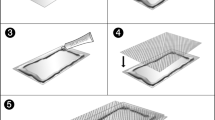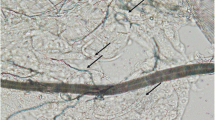Abstract
To investigate the pathogenic effects of the trypanosomeBlastocrithidia triatomae onTriatoma infestans, a method for direct infection by in vitro feeding was developed. After isolation ofB. triatomae cysts from infected dead bugs, a suspension of cysts was disinfected with Desogen and Chloramin T, then mixed with sterile blood, spread on a sterile, parallel-grooved glass plate or a hammered aluminium plate and covered with a thin, sterile silicone membrane. The blood and plate were warmed to 36°–38° C by a heating plate. For investigation of the pathological effects, first instars ofT. infestans were allowed to feed through the membrane on a mixture containing 106 cyst stages/cm3 blood. Development of about 30% of the third and fourth instar larvae was retarded as compared with that in uninfected control groups, and mortality rates increased in fourth and/or fifth instar larvae. Whereas total mortality rates of about 5% occurred in control groups, about 85% of the larvae died in the infected groups. These effects are very similar to those obtained in previous studies with coprophagic infections.
Similar content being viewed by others
References
Alekseev AN, Kulkova TA (1968) Artificial feeding ofRhodnius prolixus Stal. (Heteroptera, Triatomidae) in the laboratory. Med Parazitol Parazit Bolezni 37:702–707 (in Russian, English summary)
Bauer B, Wetzel H (1975) Effect of bacteria on tsetse flies fed through membranes. In: Sterility principle for insect control 1974. International Atomic Energy Agency, Vienna, pp 495–499
Bauer B, Wetzel H (1976) A new membrane for feedingGlossina morsitans Westw. (Diptera, Glossinidae). Bull Entomol Res 65:563–565
Christophel E-M, Scheede S, Bommer W (1988) Massenfütterung von Reduviiden mit aussortierten menschlichen Blutkonserven in Beuteln aus Haushaltsfolie: zugleich eine Möglichkeit der in-vitro-Xenodiagnose der Chagas-Krankheit. Mitt Österr Ges Tropenmed Parasitol 10:23–32
Friend WG, Hewson RJ (1978) A small volume, thermostatically controlled apparatus for feeding radioactive diets to mosquitoes and other sucking arthropods. Mosq News 38:536–541
Gardiner BOC, Maddrell SHP (1972) Techniques for routine and large-scale rearing ofRhodnius prolixus Stål. Bull Entomol Res 61:505–515
Geering-Sacher K (1973) Aufzucht keimfreier Tiere der BaumwollwanzeDysdercus fasciatus Sign. (Hemiptera, Pyrrhocoridae). Mitteil Schweiz Entomol Ges 46:125–129
Grunewald J, Wirtz H-P (1978) Künstliche Blutfütterung einiger afrikanischer und paläarktischer Simuliiden (Diptera). Z Angew Entomol 85:425–435
Harington JS (1960) A simple apparatus for the artificial feeding ofRhodnius prolixus (Hemiptera, Reduviidae). Parasitology 50:273–277
Isola ED de, Sanchez D, Katzin V (1980)Triatoma infestans: Influencia de la alimentacion artificial sobre su ciclo de vida. Medicina 40 [Suppl 1]:207–212
Jensen C, Schaub GA, Molyneux DH (1990) The effect ofBlastocrithidia triatomae (Trypanosomatidae) on the midgut of the reduviid bugTriatoma infestans. Parasitology 100:1–9
Kloft W, Schlagbauer A (1965) Eine Apparatur zur Massenfütterung blutsaugender Insekten durch künstliche Membranen. Biol Zentralbl 84:181–184
Lazzari CR, Núñez JA (1989) Blood temperature and feeding behavior inTriatoma infestans (Heteroptera: Reduviidae). Entomol Gen 14:183–188
Merks C, Werner H (1983) Xenodiagnose “in vitro”-Möglichkeit der Chagas-Diagnose. Mitt Österr Ges Tropenmed Parasitol 5:13–16
Mews AR, Langley PA, Pimley RW, Flood MET (1977) Largescale rearing of tsetse flies (Glossina spp.) in the absence of a living host. Bull Entomol Res 67:119–128
Nicolle P (1941) Appareil pour l'alimentation artificielle des réduvidés hémophages. Bull Soc Pathol Exot 34:179–185
Núñez JA, Segura EL (1988) Rearing of Triatominae. In: Brenner RR, Stoka A de la M (eds) Chagas' disease vectors, vol II. Anatomic and physiological aspects. CRC Press, Boca Raton, pp 31–40
Peng PL-M, Wallace FG (1981) The cultivation ofBlastocrithidia triatomae Cerisola et al., 1971. J Protozool 28:116–118
Pipkin AC, Connor TJ (1968) A temperature-controlled feeding apparatus for hematophagous arthropods. J Med Entomol 5:507–509
Schaub GA (1988a) Developmental time and mortality in larvae of the reduviid bugsTriatoma infestans andRhodnius prolixus after coprophagic infection withBlastocrithidia triatomae (Trypanosomatidae). J Invertebr Pathol 51:23–31
Schaub GA (1988b) Direct transmission ofTrypanosoma cruzi between vectors of Chagas' disease. Acta Trop (Basel), 45:11–19
Schaub GA (1989) DoesTrypanosoma cruzi stress its vectors? Parasitol Today 5:185–188
Schaub GA (1990) Influence of starvation of the reduviid bugTriatomae infestans on the pathological effects ofBlastocrithidia triatomae (Trypanosomatidae) and the coprophagic infection rate of the bugs. Z Angew Zool (in press)
Schaub GA, Breger B (1988) Pathological effects ofBlastocrithidia triatomae (Trypanosomatidae) on the reduviid bugsTriatoma sordida, T. pallidipennis andDipetalogaster maxima after coprophagic infection. Med Vet Entomol 2:309–318
Schaub GA, Jensen C (1990) Developmental time and mortality of the reduviid bugTriatoma infestans with differential exposure to coprophagic infections withBlastocrithidia triatomae (Trypanosomatidae). J Invertebr Pathol 55:17–27
Schaub GA, Lösch P (1989) Parasite/host-interrelationships of the trypanosomatidsTrypanosoma cruzi andBlastocrithidia triatomae and the reduviid bugTriatoma infestans: influence of starvation of the bug. Ann Trop Med Parasitol 83:215–223
Schaub GA, Schurr E, Reduth D (1988) Isolation and separation of cysts and epimastigotes ofBlastocrithidia triatomae Cerisola et al., 1971 (Trypanosomatidae). J Microbiol Methods 7:277–284
Schaub GA, Böker CA, Jensen C, Reduth D (1989) Cannibalism and coprophagy are modes of transmission ofBlastocrithidia triatomae (Trypanosomatidae) between triatomines. J Protozol 36:171–175
Schofield CJ (1979) The behaviour of Triatominae (Hemiptera: Reduviidae): a review. Bull Entomol Res 69:363–379
Shimamune A, Náquira C, Marín R (1965) Artificial feeding of the blood-sucking bugTriatoma infestans Klug, 1834: I. Feeding characteristics and the inducement of abnormal metamorphosis. Bol Chil Parasitol 20:33–42
Silva II (1958) Forma quística delTrypanosoma (Schizotrypanum) cruzi. Rev Fac Med Tucumán 1:39–66
Ubiergo GO, Niel LL, Fontanarrosa ME (1982) Artificial feeding ofTriatoma infestans (Hemiptera: Reduviidae) with defibrinated blood. J Med Entomol 19:109–110
Wetzel H (1979) Artificial membrane for in vitro feeding of piercing-sucking arthropods. Entomol Exp Appl 25:117–119
Wirtz H-P (1987) Eindringen der Mundwerkzeuge von Raubwanzen durch eine Membran (Hemiptera: Reduviidae). Entomol Gen 12:147–153
Wirtz H-P, Barthold E (1986) Simplified membrane feeding ofOrnithodoros moubata (Acarina: Argasidae) and quantitative transmission of microfilariae ofDipetalonema viteae (Nematoda: Filarioidae) to the ticks. Z Angew Zool 73:1–11
Author information
Authors and Affiliations
Rights and permissions
About this article
Cite this article
Schaub, G.A. Membrane feeding for infection of the reduviid bugTriatoma infestans withBlastocrithidia triatomae (Trypanosomatidae) and pathogenic effects of the flagellate. Parasitol Res 76, 306–310 (1990). https://doi.org/10.1007/BF00928184
Accepted:
Issue Date:
DOI: https://doi.org/10.1007/BF00928184




